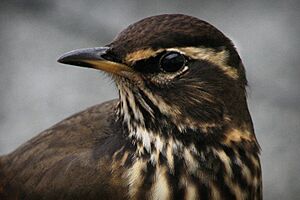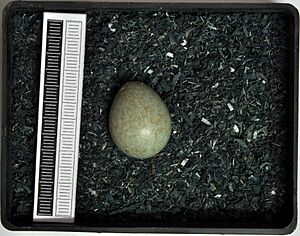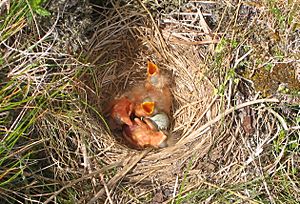Redwing facts for kids
Quick facts for kids Redwing |
|
|---|---|
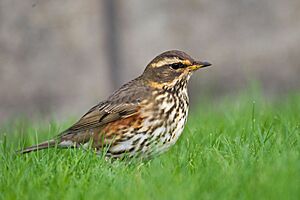 |
|
| Adult T. i. iliacus | |
| Conservation status | |
| Scientific classification | |
| Genus: |
Turdus
|
| Species: |
iliacus
|
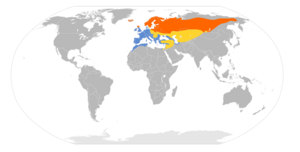 |
|
The redwing (Turdus iliacus) is a small bird in the thrush family. It is found naturally in Europe and parts of Asia. This bird is a little smaller than its cousin, the song thrush.
Contents
About the Redwing Bird
The redwing was first officially described by a famous scientist named Carl Linnaeus in 1758. He gave it its scientific name, Turdus iliacus.
The English name "redwing" comes from the bright red color under its wings. It's important to know that the redwing is not related to the "red-winged blackbird" found in North America. That's a completely different type of bird!
The scientific name Turdus iliacus comes from Latin words. Turdus means "thrush," and ile means "flank" or "side," referring to its red sides.
There are about 65 different kinds of thrushes in the Turdus group. These birds usually have rounded heads, long, pointed wings, and often sing beautiful songs. Scientists believe the redwing's ancestors traveled a long way. They think these birds came from Africa, then went to the Caribbean islands, and finally made their way to Europe.
Redwing Subspecies
The redwing has two main types, called subspecies:
- T. i. iliacus: This is the most common type. It breeds in mainland Europe and Asia.
- T. i. coburni: This type breeds in Iceland and the Faroe Islands. It spends winter in places like western Scotland, Ireland, and northern Spain. This subspecies is a bit darker and slightly bigger than the other one.
What Does a Redwing Look Like?
Redwings are about 20–24 centimeters (8–9.5 inches) long. Their wings can spread out to about 33–34.5 centimeters (13–13.5 inches). They usually weigh between 50–75 grams (1.8–2.6 ounces).
Both male and female redwings look similar. They have plain brown backs and white undersides with dark brown spots. The easiest ways to spot a redwing are its bright red sides and the creamy white stripe above its eye.
Adult redwings change their feathers between June and September. This means some birds start growing new flight feathers even while they are still feeding their young!
Redwing Song and Calls
The male redwing sings a varied, short song. When it flies, it makes a whistling call. Interestingly, redwings in different areas have slightly different songs, almost like different dialects. Birds living close to each other tend to sing very similar tunes.
A redwing's song often starts with a few notes that go up or down in pitch. These first notes can be clear and pure, or they can sound a bit rougher, like a trill. After these opening notes, the song often becomes faster and more complex. It's these starting notes that change from one area to another. In Norway, for example, these "song dialect" areas can be about 41.5 square kilometers (16 square miles) in size.
Where Do Redwings Live?
Redwings breed in the northern parts of Europe and Asia. This includes places from Iceland all the way east through Scandinavia, Russia, and even to Chukotka Autonomous Okrug. In recent years, they have started breeding in new areas, like northern Ukraine and southern Greenland.
You might find a different bird, the ring ouzel, in higher mountain areas where redwings usually don't live.
Redwing Migration
Redwings are migratory birds. This means they travel long distances. They spend their winters in western, central, and southern Europe, northwest Africa, and southwest Asia. Birds from the far eastern parts of their breeding range can fly over 6,500–7,000 kilometers (4,000–4,300 miles) to reach their winter homes!
Some redwings in the western part of their breeding range, especially in southwestern Norway, might stay in the same place all year and not migrate at all.
Sometimes, redwings get lost and end up far from their usual homes. There have been several sightings of redwings on the northeast coast of North America, and even two on the northwest coast.
Redwing Behavior and Life Cycle
When redwings migrate or spend the winter, they often gather in loose groups. These groups can have anywhere from 10 to 200 or more birds. They often feed with other birds like fieldfares, common blackbirds, and starlings. Sometimes, they also join mistle thrushes, song thrushes, and ring ouzels.
Unlike song thrushes, redwings don't usually return to the exact same wintering spots every year. They are more nomadic, meaning they move around more.
Redwings often travel at night during autumn and early winter. They make a special "Tseep" call to stay in touch with each other. This call can be heard from far away.
Redwing Reproduction
Redwings build their nests in conifer and birch forests, and in open tundra areas. They usually place their neat nests in shrubs or right on the ground.
A female redwing lays four to six eggs. Each egg is typically about 2.6 by 1.9 centimeters (1 by 0.75 inches) in size and weighs about 4.6 grams (0.16 ounces). About 5% of the egg's weight is its shell. The eggs hatch after 12–13 days.
The young chicks leave the nest when they are 12–15 days old. However, they still rely on their parents for food and care for another 14 days after leaving the nest.
What Do Redwings Eat?
Redwings are omnivores, which means they eat both plants and animals. All year round, they eat many different kinds of insects and earthworms. In autumn and winter, they also eat lots of berries. They especially like the berries from rowan trees and hawthorn bushes.
Redwing Population and Protection
The redwing lives across a very large area, estimated to be about 10 million square kilometers (3.8 million square miles). There are many redwings in Europe, with an estimated population of 26 to 40 million birds. Since Europe has about 40% of the world's redwings, the total global population could be between 98 and 151 million birds.
Even though there are many redwings, their numbers might be decreasing. Because of this, the IUCN Red List has listed the redwing as "near threatened." This means they are being watched carefully.
Very cold winters can cause many redwings to die. Also, cold and wet summers can make it harder for them to successfully raise their young.




